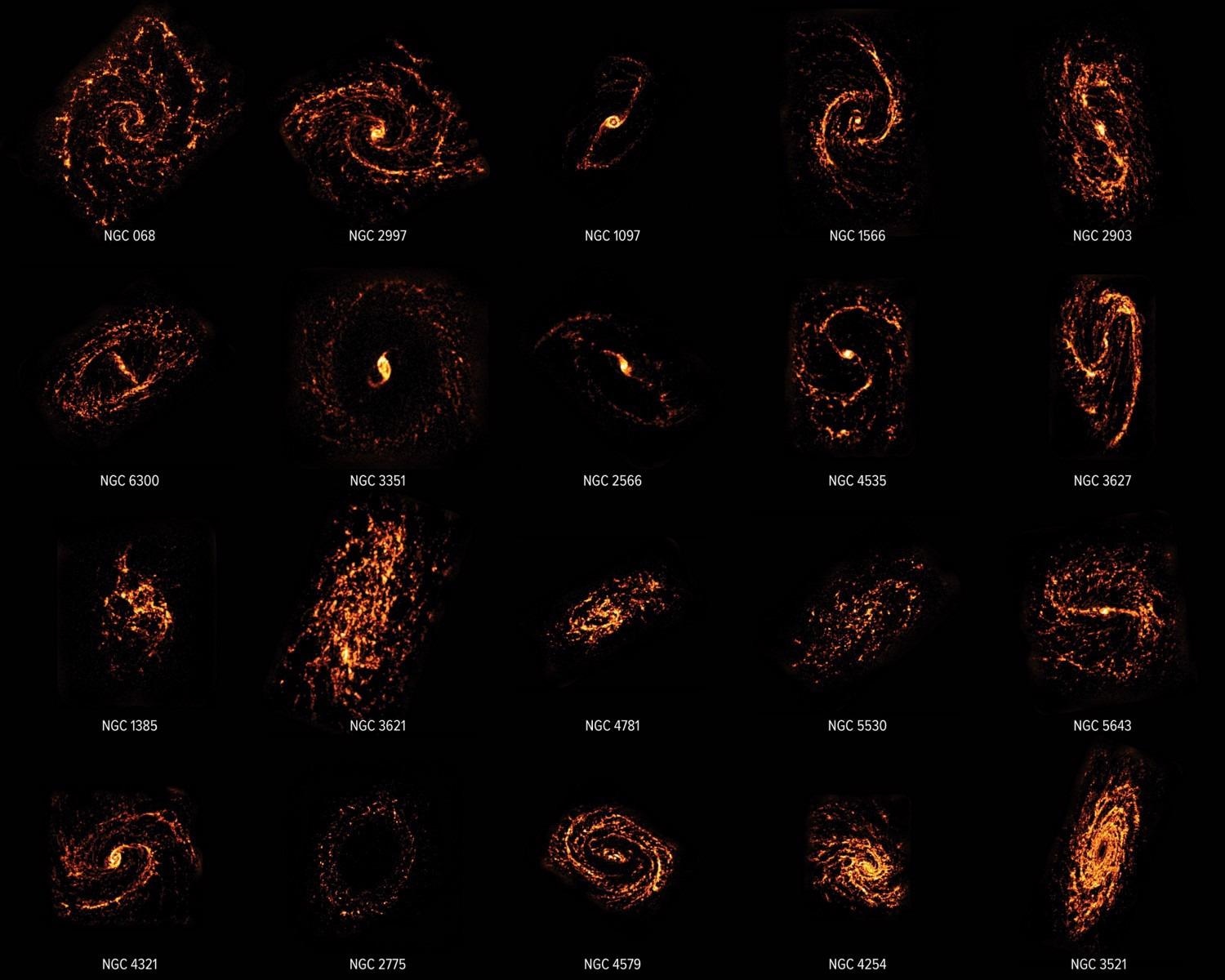Jun 9 2021
Astronomers have made a new breakthrough in interpreting the dark and violent sites where stars are born.
 Using the Atacama Large Millimeter/submillimeter Array (ALMA), scientists completed a census of nearly 100 galaxies in the nearby universe, showcasing their behaviors and appearances. The scientists compared ALMA data to that of the Hubble Space Telescope, shown in composite here. The survey concluded that contrary to popular scientific opinion, stellar nurseries do not all look and act the same. Image Credit: ALMA (ESO/NAOJ/NRAO)/PHANGS, S. Dagnello (NRAO).
Using the Atacama Large Millimeter/submillimeter Array (ALMA), scientists completed a census of nearly 100 galaxies in the nearby universe, showcasing their behaviors and appearances. The scientists compared ALMA data to that of the Hubble Space Telescope, shown in composite here. The survey concluded that contrary to popular scientific opinion, stellar nurseries do not all look and act the same. Image Credit: ALMA (ESO/NAOJ/NRAO)/PHANGS, S. Dagnello (NRAO).
In the last five years, an international research group has performed the first systematic survey of “stellar nurseries” across a portion of the universe, mapping over 100,000 of these stellar nurseries across more than 90 galaxies in the vicinity and offering a new understanding of the origins of stars.
Every star in the sky, including our own sun, was born in one of these stellar nurseries. These nurseries are responsible for building galaxies and making planets, and they’re just an essential part in the story of how we got here. But this is really the first time we have gotten a complete view of these stellar nurseries across the whole nearby universe.
Adam Leroy, Project Leader and Associate Professor of Astronomy, The Ohio State University
The project is dubbed PHANGS-ALMA, and the study was possible thanks to the ALMA telescope array deployed high in the Andes mountains in Chile.
Being the world’s most powerful radio telescope, ALMA is an international facility that largely involves the U.S. and is headed by the National Science Foundation and National Radio Astronomy Observatory.
The facility’s power enabled the researchers to survey the stellar nurseries across a different set of 90 galaxies, while earlier studies had mainly targeted a part of one galaxy or an individual galaxy.
When optical telescopes take pictures, they capture the light from stars. When ALMA takes a picture, it sees the glow from the gas and dust that will form stars. The new thing with PHANGS-ALMA is that we can use ALMA to take pictures of many galaxies, and these pictures are as sharp and detailed as those taken by optical telescopes. This just hasn’t been possible before.
Jiayi Sun, PhD Student, The Ohio State University
Jiayi Sun is completing a thesis based on the survey in June 2021.
According to Leroy, the survey has extended the amount of data on stellar nurseries by tenfold. These details have given astronomers a much more precise picture of the appearance of these nurseries across our corner of the universe.
Based on these findings, the team has discovered that stellar nurseries are unexpectedly different across galaxies, survive only a comparatively short time in astronomical terms, and are not highly efficient at making stars.
For the researchers, the diversity of such stellar nurseries was quite unexpected.
For a long time, conventional wisdom among astronomers was that all stellar nurseries looked more or less the same. But with this survey, we can see that this is really not the case. While there are some similarities, the nature and appearance of these nurseries change within and among galaxies, just like cities or trees may vary in important ways as you go from place to place across the world.
Jiayi Sun, PhD Student, The Ohio State University
For instance, nurseries present in bigger galaxies, and those located in the core of galaxies, are denser, more turbulent, and more massive, added Sun. The study also indicated that the formation of stars is relatively more violent in these clouds.
“So the properties of these nurseries and even their ability to make stars seem to depend on the galaxies they live in,” added Sun.
The survey results also demonstrated that such stellar nurseries live for only 10 to 30 million years, which is a comparatively short time from an astronomical perspective. The researchers also utilized the same measurements to determine how efficiently these stellar nurseries converted their dust and gas into stars — but it was observed that they were not that efficient.
Leroy added, “This survey is allowing us to build a much more complete picture of the life cycle of these regions, and we’re finding they are short-lived and inefficient. It’s not random chance destroying these nurseries, but the new stars that they make. They are very ungrateful children.”
The heat and radiation emitting from these new stars start to scatter and dissolve the clouds, ultimately destroying them before they can change most of their mass.
After more than five years of observations, the survey was recently finished and outlined by the PHANGS-ALMA group in two new articles that have been accepted in the Astrophysical Journal Supplement Series.
The publication of these two articles has set a new benchmark, and the information gathered by the project team is publicly available today. Earlier, the team had used PHANGS-ALMA to create over 20 scientific publications. Ten articles describing the results of the PHANGS survey are now being presented at the 238th meeting of the American Astronomical Society.
“We have an incredible dataset here that will continue to be useful. This is really a new view of galaxies and we expect to be learning from it for years to come,” Leroy concluded.
Journal Reference:
Leroy, A. K., et al. (2021) PHANGS-ALMA: Arcsecond CO(2-1) Imaging of Nearby Star-Forming Galaxies.